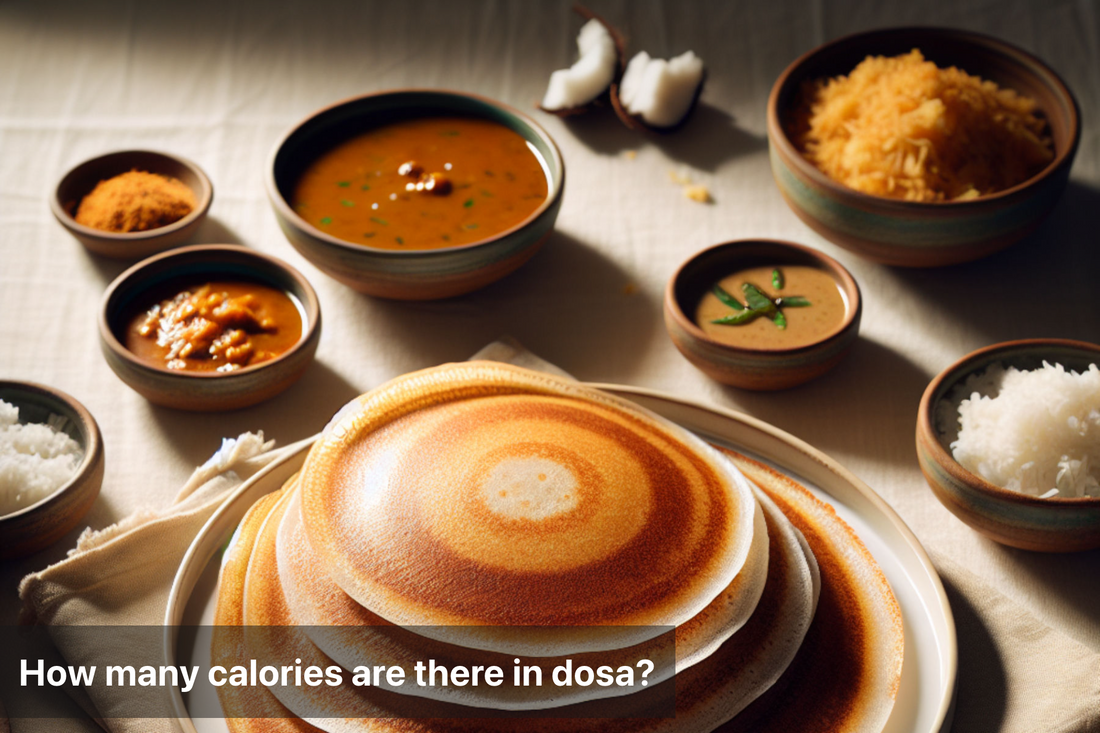
How many calories are there in dosa?
Share
Dosa is one of the most iconic South Indian dishes enjoyed across India and beyond. Made from a fermented batter of rice and urad dal, dosa is known for being light, crispy, and versatile—served plain or stuffed, with chutney, sambar, or ghee. But if you're watching your calorie intake, you might wonder: how many calories are there in a dosa?
This blog explores the calorie content of different types of dosa, how cooking methods and accompaniments affect their nutrition, and how dosa fits into a balanced diet.
What Is a Dosa?
A dosa is a thin, crepe-like pancake made by spreading fermented rice-lentil batter on a hot griddle. Traditionally served as a breakfast or light meal, dosa is appreciated for being naturally gluten-free, easy to digest, and highly customizable
Common types of dosa include:
Plain Dosa: Basic, crispy dosa without stuffing
Masala Dosa: Stuffed with a spiced potato filling
Ghee Dosa: Brushed generously with ghee
Rava Dosa: Made with semolina instead of fermented batter
Set Dosa: Thick and soft, often served in stacks
Calories in a Plain Dosa
A standard homemade plain dosa made with minimal oil contains around 120 to 150 calories
Dosa Type (1 piece) |
Calories |
Carbs |
Protein |
Fat |
|---|---|---|---|---|
Plain Dosa (homemade, 100g) |
120–150 kcal |
20–25g |
2–3g |
3–4g |
Masala Dosa (stuffed) |
200–250 kcal |
30–35g |
4–5g |
8–10g |
Ghee Roast Dosa |
250–300 kcal |
30g |
4g |
12–15g |
Rava Dosa (restaurant style) |
170–210 kcal |
25–30g |
3–4g |
6–8g |
Set Dosa (1 thick piece) |
180–200 kcal |
28g |
4g |
5g |
Values vary depending on size, oil usage, and batter composition
What Affects the Calorie Content of Dosa?
1. Batter Ratio and Ingredients
Traditional dosa uses a 3:1 ratio of rice to urad dal
Higher urad dal content increases protein
Rava dosa uses semolina, which digests faster and may have more calories due to added oil
2. Cooking Method
Non-stick pans reduce the need for oil
Iron tavas may require extra oil or ghee
Brushing with ghee or butter can add 50–100 calories easily
3. Size and Thickness
Thin, paper-style dosas are lighter than thick or restaurant-sized dosas
Set dosas and restaurant servings are often larger and more calorie-dense
4. Fillings and Stuffing
Masala dosa includes a spiced potato mixture made with oil or ghee
Cheese, paneer, or chicken stuffing adds more fat and protein
Macronutrient Profile of a Basic Homemade Dosa (100g)
Calories: 140 kcal
Carbohydrates: 22g
Protein: 3g
Fat: 4g
Fiber: 1–2g
Cholesterol: 0mg (unless ghee or butter is added)
Dosa offers complex carbs, some protein from urad dal, and minimal fat when cooked with less oil
Comparison with Other Indian Breakfasts
Dish |
Calories |
Protein |
Fat |
|---|---|---|---|
Plain Dosa |
140 |
3g |
4g |
Masala Dosa |
230 |
5g |
9g |
Idli (1 medium) |
60–70 |
2g |
<1g |
Upma (1 bowl) |
190–210 |
4g |
6g |
Paratha (1, plain) |
220–250 |
4g |
10g |
Poha (1 bowl) |
180–200 |
3g |
5g |
Dosa is a moderate-calorie, low-fat breakfast when eaten plain, especially when compared to fried or heavily stuffed items
Health Benefits of Dosa
Fermented Food
Enhances gut health with beneficial probiotics
Increases bioavailability of nutrients in dal and rice
Naturally Gluten-Free
Suitable for gluten-intolerant individuals when prepared traditionally
Light and Digestible
Easy on the stomach, especially when served without excess oil or stuffing
Versatile and Balanced
Add protein-rich fillings like paneer or tofu
Serve with chutney and sambar for a complete meal with carbs, protein, fiber, and micronutrients
Tips to Make Dosa Healthier
Use minimal oil or ghee during cooking
Opt for brown rice or millets in the batter to increase fiber
Add soaked methi seeds (fenugreek) for better digestion and mineral absorption
Try moong dal or multigrain dosas for higher protein and diversity
Pair with coconut or mint chutney without tempering to keep it light
Avoid high-fat fillings like cheese or heavy butter masalas
Ideal Serving Size
One medium dosa (plain or masala) is typically enough for a meal when paired with sambar and chutney
For a balanced breakfast or light lunch, stick to 1–2 dosas with vegetable sides
When to Eat Dosa
Breakfast: Energizing yet light
Lunch: Add a protein filling for satiety
Dinner: Choose plain dosa or ragi dosa with light chutney for a low-fat option
Avoid dosa at late night hours if you are prone to acid reflux or indigestion
Conclusion
So, how many calories are there in one dosa? A plain, homemade dosa contains around 120 to 150 calories, while masala dosa ranges from 200 to 250 calories depending on stuffing and oil use. Ghee roast dosas and restaurant versions may cross 300+ calories per piece
When made mindfully, dosa can be a part of a balanced Indian diet. Fermented, naturally gluten-free, and easily digestible, dosa offers comfort without compromising on nutrition—especially when paired with fiber-rich chutneys and protein-filled sambar






